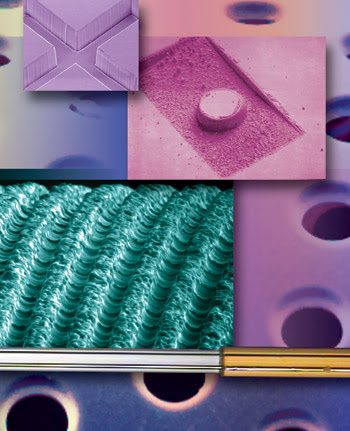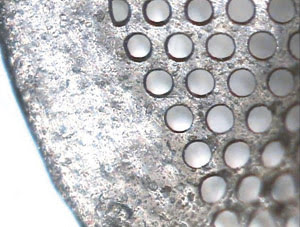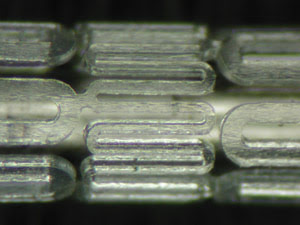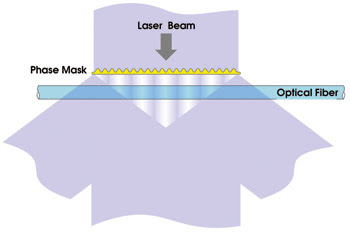A new generation of easy-to-use excimer lasers is bringing the benefits of high-power output to diverse industrial applications.
Dr. Tobias Damm, Coherent Lambda Physik GmbH
Excimers are pulsed gas lasers that deliver high pulse energies and high average output at ultraviolet and deep-ultraviolet wavelengths. As a result, the list of applications for excimer lasers continues to expand, in contrast to other types of gas lasers. Standout applications include silicon annealing in flat panel displays, refractive ophthalmic surgeries, micromachining plastics, microlithography and marking glass products. For many of these, ease of use and high reliability are economic prerequisites.
To satisfy these needs, excimer manufacturers have developed a new generation of products offering unprecedented reliability, simple operation and long-lived consumables.
The heart of an excimer laser is the discharge tube, which is filled with a low-pressure mixture of an inert gas such as krypton, argon or xenon and a halogen or halide gas such as fluorine or hydrogen chloride. It then is pressurized with a “buffer gas” of either neon or helium.
The laser is pulsed by discharging up to 40 kV across two parallel electrodes running along the laser tube. The resultant plasma contains a high concentration of an excited transient complex — e.g., ArF, KrF, XeCl or F2 — that emits ultraviolet laser radiation. To obtain a smooth discharge and a homogeneous beam, the gas in the tube must be preionized, which was achieved in early excimers by using a spark discharge.
Unfortunately, those early excimers established a negative reputation because of limited gas and tube lifetimes, the need for frequent optics cleaning, complex gas refilling procedures and other maintenance issues. Although these practical limitations have been addressed, this now-outdated idea of the troublesome excimer laser persists in the photonics industry, particularly among those who lack firsthand experience with the new generation of excimers.
In the past, gas fill lifetime was relatively short because of the buildup of dust and chemical byproducts from the reactive effects of the high-voltage discharge and halogen gas with the tube materials. This corrosion also limited the lifetime of the tube.
These problems have been solved with a twofold approach. First, corrosion has been virtually eliminated by switching to plasma tubes that contain only ceramics and corrosion-resistant metals such as pure nickel. Second, internal gas recirculation systems now incorporate both physical and electrostatic filters to trap even slight amounts of dust that might form over time. Moreover, these gas recirculation systems are designed to blow freshly filtered gas directly on the optics.
As a result, in the past five years alone, gas and tube lifetimes have increased by an order of magnitude. Some types of excimer lasers achieve tube lifetimes of more than 10 billion pulses at 193 and 248 nm.
Another important development has been the use of solid-state switches to replace the gas thyratrons formerly used to switch the high voltage. This has eliminated thyratron failure in industrial excimers. In addition, manufacturers of excimers have developed innovative preionization technologies — such as a ceramic smooth discharge — that eliminate sparking in the plasma tube, which had created dust and had limited the lifetime of the spark pins.
Lastly, computer control and the widespread availability of premixed laser gas have combined to simplify laser operation and maintenance. Depending on usage, the gas is now refilled after several weeks by a simple pushbutton command from the laser operator.
Medical disposables
A dynamic field in medicine today is minimally invasive surgery, particularly involving intravenous techniques. Minimally invasive surgery reduces costs, accelerates patient recovery and generally improves prognoses. It relies on the use of tiny plastic tools and devices, which often are disposable products that must be fabricated cost-effectively. The excimer laser is perfect for this task because its high power translates into fast processing times and, hence, high throughput.

Excimers are involved in the creation of a variety of disposable medical devices, where they are used to cut, drill, skive and strip plastics. Courtesy of Resonetics Inc.
Resonetics Inc. in Nashua, N.H., is a laser applications company that offers prototyping and volume manufacturing on a subcontracting basis as well as the manufacture of integrated systems. It is a supplier of this new generation of medical devices. David Wall, director of laser applications at the company, noted that the market has evolved over the past few years from featuring a few types of fairly simple products to include drug-eluting and bioabsorbable stents, stent grafts, embolic filters, valve replacements, femoral closures, and precision drug delivery, thrombus extraction and neurological devices.
To develop the technology to address this diverse market, the company has set up multiple application groups. Group leader Rong Gu said that a particular focus of minimally invasive surgery involves improvements in the treatment of blocked blood vessels through the use of embolic protection devices (Figure 1). To prevent a stroke during the extraction of a blood clot, these parachute-shaped filters feature small holes that enable blood to continue to flow while trapping any clots that may form. Excimer lasers are well-suited to the micromachining of these tiny holes.

Figure 1. Embolic filters are used to trap the debris created when reopening damaged blood vessels. Courtesy of Resonetics.
Application group leader Brian Hall pointed to the potential of excimer lasers for the production of next-generation stents in polymer. In some patients, the body responds to the presence of a metal stent by depositing plaque and forming scar tissue that can reblock the blood vessel, called restenosis. The use of biodegradable plastic stents impregnated with a drug may be a solution to this problem (Figure 2). Over several weeks, the stent erodes, simultaneously releasing the antirestenosis drug.

Figure 2. A polymer stent is a meshlike tube created from biodegradable plastic that has been impregnated with an antirestenosis drug. Courtesy of Resonetics.
Resonetics uses more than 50 excimer lasers. The majority operate at 248 or 193 nm, optimum wavelengths for processing the polyurethane, nylon, Pebax, bioabsorbables and polyimide materials used in this field. Hall noted that excimers offer high processing speeds and product quality, which are the two most important goals in fabricating these products.
Writing gratings
Fiber Bragg gratings are specialized fiber optics in which the refractive index varies in a periodic pattern along the length of the fiber. As a result, the transmission and/or reflectance of a fiber Bragg grating becomes wavelength-specific. Moreover, these parameters are sensitive to changes in temperature and to strain.
The gratings are used in sensing, telecommunications and fiber laser applications. Telecommunications applications include their use as pump laser stabilizers at both 980 and 1480 nm. In the area of fiber lasers, fiber Bragg gratings are widely used as cavity mirrors.

Figure 3. Some fiber Bragg grating devices are incorporated into crack sensors to monitor subway tunnels.
As a sensor, a fiber loop is embedded in the system to be monitored, such as a subway tunnel, a freeway bridge or a power plant (Figure 3). Changes in pressure and temperature, as well as physical expansion, contraction and bending of the fiber, cause a deformation of the fiber Bragg grating. This alters the grating’s transmission/reflection spectrum, which is probed by a dedicated light source such as a laser or a superluminescent LED.
Fiber Bragg gratings are created by using intense UV laser radiation to modify the chemical and physical properties of the fiber core, changing its index. QPS Photronics Inc. of Pointe-Claire, Quebec, Canada, manufactures fiber Bragg gratings and supplies turnkey systems for other manufacturers. Peter Kung, president of QPS Photronics, said that the excimer laser is a critical enabling tool for the company.
“Several methods have been demonstrated using both pulsed and CW ultraviolet lasers, but the high power of the excimer translates into faster production times, higher throughput and lower product cost,” he said. He noted that a CW laser may take many minutes to create a grating but that the company’s automated excimer-based system can generate a complex grating in one to two minutes.
The most common fiber Bragg gratings are produced by exposing a germanium-doped fiber with a 248-nm excimer. The required interference pattern is created by passing the laser output through a beam homogenizer, through shaping optics that create a long, thin line and then through a phase mask. The mask splits the beam into several diffractive orders, and interference among these beams creates the required pattern (see Figure 4).

Figure 4. Fiber Bragg grating fabrication uses a phase mask to create an interference pattern that produces the desired periodic grating structure in a length of fiber.
Recently, the company began using 193-nm excimer lasers. This wavelength enables it to create index gratings in nitrogen-doped fibers, which are then used as sensors in high-temperature — e.g., 700 °C — applications such as power plants and incinerators.
Kung said that the longevity of excimer lasers will help manufacturers of gratings maintain profit margins as production increases. Even in the relatively high volume production environment at QPS Photronics, some of its excimers are 6 to 7 years old and yet are operating on their original tube.
Conclusion
Technological developments have made the excimer laser a reliable workhorse that operates in demanding industrial environments. Its unique ability to deliver UV high power and high pulse energies enables processing techniques that cannot be accomplished using any other laser type, thus ensuring their widespread use for the foreseeable future.
Meet the author
Tobias Damm is managing director at Coherent Lambda Physik GmbH in Göttingen, Germany; e-mail: [email protected].